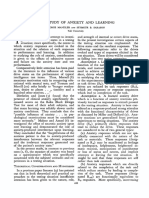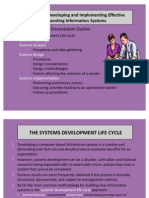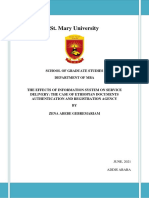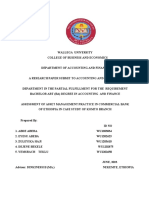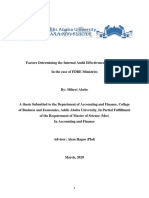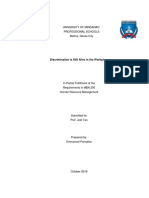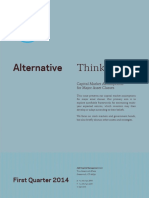0 ratings0% found this document useful (0 votes)
287 views17 Database Design Using The REA Data Model
Use the REA data model to design an AIS database. Read an REA diagram and explain what it reveals about the business activities and policies of the organization being modeled.
Uploaded by
ayutitiekCopyright
© © All Rights Reserved
Available Formats
Download as PPTX, PDF, TXT or read online on Scribd
0 ratings0% found this document useful (0 votes)
287 views17 Database Design Using The REA Data Model
Use the REA data model to design an AIS database. Read an REA diagram and explain what it reveals about the business activities and policies of the organization being modeled.
Uploaded by
ayutitiekCopyright
© © All Rights Reserved
Available Formats
Download as PPTX, PDF, TXT or read online on Scribd
You are on page 1/ 15
Chapter 17
Database Design Using the REA Data Model
Copyright 2012 Pearson Education, Inc. publishing as Prentice Hall
17-1
Learning Objectives
Discuss the steps for designing and implementing a
database system.
Use the REA data model to design an AIS database.
Draw an REA diagram of an AIS database.
Read an REA diagram and explain what it reveals about
the business activities and policies of the organization
being modeled.
Copyright 2012 Pearson Education, Inc. publishing as Prentice Hall 17-2
Database Design Process
Copyright 2012 Pearson Education, Inc. publishing as Prentice Hall 17-3
The System Analysis Process
Systems Analysis
Initial planning to determine the need for and feasibility of developing a new
system
Judgments about the proposals technological and economic feasibility
Identify user information needs
Define the scope of the proposed new system
Gather information about the expected number of users and transaction
volumes to make preliminary decisions about hardware and software
requirements
Conceptual Design
Developing the different schemas for the new system at the conceptual,
external, and internal levels
Copyright 2012 Pearson Education, Inc. publishing as Prentice Hall 17-4
The System Analysis Process (contd)
Physical Design
Translating the internal-level schema into the actual database structures that
will be implemented in the new system
New applications are developed
Implementation and Conversion
Includes all the activities associated with transferring data from existing
systems to the new database AIS
Testing the new system
Training employees
Maintaining the New System
Data Modeling
Process of defining an information system so it represents
an organizations requirements
Occurs at two stages of the design process:
System analysis
Conceptual design
Data models:
Data flow diagrams (Chapter 3)
Flow charts (Chapter 3)
Entity-relationship diagrams (Chapter 17)
Copyright 2012 Pearson Education, Inc. publishing as Prentice Hall 17-6
Entity-Relationship Diagrams
Used to graphically represent a database schema
Depicts entities
Anything an organization wants to collect information about
Relationships between entities
Copyright 2012 Pearson Education, Inc. publishing as Prentice Hall 17-7
E-R Diagram Variations
Copyright 2012 Pearson Education, Inc. publishing as Prentice Hall 17-8
Resources-Events-Agents Diagram
Developed for designing AIS
Categorizing entities into:
Resources
Things that have economic value
Events
Business activities
Management wants to manage and control
Agents
People and organizations that participate in events
Copyright 2012 Pearson Education, Inc. publishing as Prentice Hall 17-9
REA Diagram Rules
1. Each event is linked to at least one resource that it
affects.
2. Each event is linked to at least one other event.
Types of links (relationships):
Get events
Give events
Participation events
3. Each event is linked to at least two participating agents.
Copyright 2012 Pearson Education, Inc. publishing as Prentice Hall 17-10
Business Cycle GiveGet Relationships
Copyright 2012 Pearson Education, Inc. publishing as Prentice Hall 17-11
Revenue Cycle REA Diagram
Copyright 2012 Pearson Education, Inc. publishing as Prentice Hall 17-11
Developing an REA Diagram
1. Identify the events about which management wants to
collect information.
2. Identify the resources affected by each event and the
agents who participate in those events.
What economic resource is reduced by the Give event?
What economic resource is acquired by the Get event?
What economic resource is affected by a commitment
event?
3. Determine the cardinalities of each relationship.
Copyright 2012 Pearson Education, Inc. publishing as Prentice Hall 17-13
Cardinalities
Describe the nature of relationships between entities
How many instances of one entity can be linked to each specific instance of
another entity
Minimum can be: 0 or 1
Maximum can be: 1 or Many
Copyright 2012 Pearson Education, Inc. publishing as Prentice Hall 17-14
Three Types of Relationships
Relationship type is based on maximum cardinality:
One-to-One:
One-to-Many:
Many-to-Many:
Copyright 2012 Pearson Education, Inc. publishing as Prentice Hall 17-15
You might also like
- Additive Manufacturing of Ceramics and Cermets: Present Status and Future PerspectivesNo ratings yetAdditive Manufacturing of Ceramics and Cermets: Present Status and Future Perspectives35 pages
- Database Design Using The REA Data ModelNo ratings yetDatabase Design Using The REA Data Model15 pages
- Effect of Strategic Human Resource Management Practice On Organization Citizenship Behaviors Study On Commercial Bank of Ethiopia Jimma DistrictNo ratings yetEffect of Strategic Human Resource Management Practice On Organization Citizenship Behaviors Study On Commercial Bank of Ethiopia Jimma District14 pages
- Budget Preparation Allocation and Utilization (A Case Study On Silte Zone Finance OrganizationNo ratings yetBudget Preparation Allocation and Utilization (A Case Study On Silte Zone Finance Organization34 pages
- Database Design Using The REA Data ModelNo ratings yetDatabase Design Using The REA Data Model9 pages
- The Impact of Information and Communication Technology On Performance of Commercial Banks in EthiopiaNo ratings yetThe Impact of Information and Communication Technology On Performance of Commercial Banks in Ethiopia78 pages
- The Legal Protection of Minority Shareholders Under Ethiopian Law: Comparative AnalysisNo ratings yetThe Legal Protection of Minority Shareholders Under Ethiopian Law: Comparative Analysis18 pages
- Biniyam Yitbarek Article Review On Financial Analysis100% (1)Biniyam Yitbarek Article Review On Financial Analysis6 pages
- Effect of Information Communication Technology On Human Resource Productivity of Iranian National Oil CompanyNo ratings yetEffect of Information Communication Technology On Human Resource Productivity of Iranian National Oil Company6 pages
- Ais Development Strategies Suggested Answers To Discussion QuestionsNo ratings yetAis Development Strategies Suggested Answers To Discussion Questions33 pages
- The Trial Balance and The Other Information For Consulting Engineers PDFNo ratings yetThe Trial Balance and The Other Information For Consulting Engineers PDF2 pages
- The Contribution of Micro Finance Institution in Creating Small Business Enterpr100% (1)The Contribution of Micro Finance Institution in Creating Small Business Enterpr46 pages
- CH10 Developing and Implementing Effective AISNo ratings yetCH10 Developing and Implementing Effective AIS27 pages
- The Impact of Accounting Information Systems On The Banks Success: Evidence From JordanNo ratings yetThe Impact of Accounting Information Systems On The Banks Success: Evidence From Jordan14 pages
- Assignemnt On Labour Procla in EthiopiaNo ratings yetAssignemnt On Labour Procla in Ethiopia15 pages
- Harambee University: School of Business and Economics Department of Business AdministrationNo ratings yetHarambee University: School of Business and Economics Department of Business Administration12 pages
- Zena Abebe MBA Section H Final Thesis PaperNo ratings yetZena Abebe MBA Section H Final Thesis Paper80 pages
- The Impact of Leadership Style On Employee's Performance-An Analysis On The Effect of Leadership Style On Staff Retention: Case Study, Rokel Commercial Bank, Sierra LeoneNo ratings yetThe Impact of Leadership Style On Employee's Performance-An Analysis On The Effect of Leadership Style On Staff Retention: Case Study, Rokel Commercial Bank, Sierra Leone9 pages
- What Should Be The Fate of The Current Provisions Governing Joint Venture in The Forthcoming Revised Commercial Code of Ethiopia? Retention or Exclusion?No ratings yetWhat Should Be The Fate of The Current Provisions Governing Joint Venture in The Forthcoming Revised Commercial Code of Ethiopia? Retention or Exclusion?18 pages
- Material Managemnt Chapter Four and Five With Reference - 040530100% (1)Material Managemnt Chapter Four and Five With Reference - 04053015 pages
- Chapter IX Accounting For Fiduciary FundsNo ratings yetChapter IX Accounting For Fiduciary Funds12 pages
- Assessment of The Opportunities and Challenges For The Adoption of E-Banking Service (The Case of Commercial Bank of Ethiopia)No ratings yetAssessment of The Opportunities and Challenges For The Adoption of E-Banking Service (The Case of Commercial Bank of Ethiopia)76 pages
- Discrimination Is Still Alive in The WorkplaceNo ratings yetDiscrimination Is Still Alive in The Workplace6 pages
- Assignemnt On Labour Procla in EthiopiaNo ratings yetAssignemnt On Labour Procla in Ethiopia10 pages
- Database Design Using The REA Data ModelNo ratings yetDatabase Design Using The REA Data Model15 pages
- Nama Payroll - Id Dept Ptkp1 Ptkp2 Grade Hiredate Basic TransportNo ratings yetNama Payroll - Id Dept Ptkp1 Ptkp2 Grade Hiredate Basic Transport2 pages
- 12 The Revenue Cycle - Sales To Cash CollectionNo ratings yet12 The Revenue Cycle - Sales To Cash Collection18 pages
- Migrating AS400-COBOL To Java A Report From The Field: Harry - Sneed@t-Online - de Katalin - Erdos1@t-Online - HuNo ratings yetMigrating AS400-COBOL To Java A Report From The Field: Harry - Sneed@t-Online - de Katalin - Erdos1@t-Online - Hu10 pages
- Shake Table Testin of A Multi-Tower Connected Hybrid Structure - Zhou Ying, Lu Xilin, Lu Wensheng, He Zhijun - Marzo 2009No ratings yetShake Table Testin of A Multi-Tower Connected Hybrid Structure - Zhou Ying, Lu Xilin, Lu Wensheng, He Zhijun - Marzo 200913 pages
- AQR (2014) Capital Market Assumptions For Major Asset ClassesNo ratings yetAQR (2014) Capital Market Assumptions For Major Asset Classes12 pages
- Fast Combinational Architecture For A Vedic DividerNo ratings yetFast Combinational Architecture For A Vedic Divider5 pages
- Deep Learning in C# - Understanding Neural Network Architecture - CodeProjectNo ratings yetDeep Learning in C# - Understanding Neural Network Architecture - CodeProject4 pages
- Powershell' Deep Dive:: A United Threat Research ReportNo ratings yetPowershell' Deep Dive:: A United Threat Research Report16 pages
- Exp19 Excel Ch08 HOEAssessment Robert's Flooring InstructionsNo ratings yetExp19 Excel Ch08 HOEAssessment Robert's Flooring Instructions1 page
- dsineDN DU ROM Extended DN2 Product Manual 1.0No ratings yetdsineDN DU ROM Extended DN2 Product Manual 1.02 pages
- Tekla Structural Designer 2022 Eurocodes ReferenceNo ratings yetTekla Structural Designer 2022 Eurocodes Reference226 pages
- ST5227 Applied Data Mining: Sun Baoluo, Chan Hock Peng100% (1)ST5227 Applied Data Mining: Sun Baoluo, Chan Hock Peng24 pages
- Bulb Units The Complete Solution For Low Heads: Power100% (1)Bulb Units The Complete Solution For Low Heads: Power12 pages
- DuctWatch IR Gas Detector Instruction ManualNo ratings yetDuctWatch IR Gas Detector Instruction Manual32 pages
- Additive Manufacturing of Ceramics and Cermets: Present Status and Future PerspectivesAdditive Manufacturing of Ceramics and Cermets: Present Status and Future Perspectives
- Effect of Strategic Human Resource Management Practice On Organization Citizenship Behaviors Study On Commercial Bank of Ethiopia Jimma DistrictEffect of Strategic Human Resource Management Practice On Organization Citizenship Behaviors Study On Commercial Bank of Ethiopia Jimma District
- Budget Preparation Allocation and Utilization (A Case Study On Silte Zone Finance OrganizationBudget Preparation Allocation and Utilization (A Case Study On Silte Zone Finance Organization
- The Impact of Information and Communication Technology On Performance of Commercial Banks in EthiopiaThe Impact of Information and Communication Technology On Performance of Commercial Banks in Ethiopia
- The Legal Protection of Minority Shareholders Under Ethiopian Law: Comparative AnalysisThe Legal Protection of Minority Shareholders Under Ethiopian Law: Comparative Analysis
- Biniyam Yitbarek Article Review On Financial AnalysisBiniyam Yitbarek Article Review On Financial Analysis
- Effect of Information Communication Technology On Human Resource Productivity of Iranian National Oil CompanyEffect of Information Communication Technology On Human Resource Productivity of Iranian National Oil Company
- Ais Development Strategies Suggested Answers To Discussion QuestionsAis Development Strategies Suggested Answers To Discussion Questions
- The Trial Balance and The Other Information For Consulting Engineers PDFThe Trial Balance and The Other Information For Consulting Engineers PDF
- The Contribution of Micro Finance Institution in Creating Small Business EnterprThe Contribution of Micro Finance Institution in Creating Small Business Enterpr
- The Impact of Accounting Information Systems On The Banks Success: Evidence From JordanThe Impact of Accounting Information Systems On The Banks Success: Evidence From Jordan
- Harambee University: School of Business and Economics Department of Business AdministrationHarambee University: School of Business and Economics Department of Business Administration
- The Impact of Leadership Style On Employee's Performance-An Analysis On The Effect of Leadership Style On Staff Retention: Case Study, Rokel Commercial Bank, Sierra LeoneThe Impact of Leadership Style On Employee's Performance-An Analysis On The Effect of Leadership Style On Staff Retention: Case Study, Rokel Commercial Bank, Sierra Leone
- What Should Be The Fate of The Current Provisions Governing Joint Venture in The Forthcoming Revised Commercial Code of Ethiopia? Retention or Exclusion?What Should Be The Fate of The Current Provisions Governing Joint Venture in The Forthcoming Revised Commercial Code of Ethiopia? Retention or Exclusion?
- Material Managemnt Chapter Four and Five With Reference - 040530Material Managemnt Chapter Four and Five With Reference - 040530
- Assessment of The Opportunities and Challenges For The Adoption of E-Banking Service (The Case of Commercial Bank of Ethiopia)Assessment of The Opportunities and Challenges For The Adoption of E-Banking Service (The Case of Commercial Bank of Ethiopia)
- Nama Payroll - Id Dept Ptkp1 Ptkp2 Grade Hiredate Basic TransportNama Payroll - Id Dept Ptkp1 Ptkp2 Grade Hiredate Basic Transport
- Migrating AS400-COBOL To Java A Report From The Field: Harry - Sneed@t-Online - de Katalin - Erdos1@t-Online - HuMigrating AS400-COBOL To Java A Report From The Field: Harry - Sneed@t-Online - de Katalin - Erdos1@t-Online - Hu
- Shake Table Testin of A Multi-Tower Connected Hybrid Structure - Zhou Ying, Lu Xilin, Lu Wensheng, He Zhijun - Marzo 2009Shake Table Testin of A Multi-Tower Connected Hybrid Structure - Zhou Ying, Lu Xilin, Lu Wensheng, He Zhijun - Marzo 2009
- AQR (2014) Capital Market Assumptions For Major Asset ClassesAQR (2014) Capital Market Assumptions For Major Asset Classes
- Fast Combinational Architecture For A Vedic DividerFast Combinational Architecture For A Vedic Divider
- Deep Learning in C# - Understanding Neural Network Architecture - CodeProjectDeep Learning in C# - Understanding Neural Network Architecture - CodeProject
- Powershell' Deep Dive:: A United Threat Research ReportPowershell' Deep Dive:: A United Threat Research Report
- Exp19 Excel Ch08 HOEAssessment Robert's Flooring InstructionsExp19 Excel Ch08 HOEAssessment Robert's Flooring Instructions
- Tekla Structural Designer 2022 Eurocodes ReferenceTekla Structural Designer 2022 Eurocodes Reference
- ST5227 Applied Data Mining: Sun Baoluo, Chan Hock PengST5227 Applied Data Mining: Sun Baoluo, Chan Hock Peng
- Bulb Units The Complete Solution For Low Heads: PowerBulb Units The Complete Solution For Low Heads: Power


